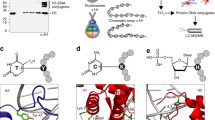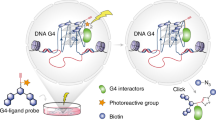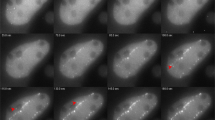Abstract
The formation of protein aggregates (foci) at sites of DNA double-strand breaks (DSBs) is mainly studied by immunostaining and is hence limited by the low resolution of light microscopy and the availability of appropriate and selective antibodies. Here, we describe a system using enzymatic creation of site-specific DNA DSBs within the human genome combined with chromatin immunoprecipitation (ChIP) that enables molecular probing of a DSB. Following induction of the I-PpoI enzyme and generation of DSBs, cellular DNA and proteins are crosslinked and analyzed by ChIP for specific proteins at the site of the break. The system allows the direct detection of protein and chromatin dynamics at the site of the break with high resolution, as well as direct measurement of DNA repair defects in human cells. Starting with fragmented chromatin, results can be achieved in 2–3 d.
This is a preview of subscription content, access via your institution
Access options
Subscribe to this journal
Receive 12 print issues and online access
$259.00 per year
only $21.58 per issue
Buy this article
- Purchase on Springer Link
- Instant access to full article PDF
Prices may be subject to local taxes which are calculated during checkout

Similar content being viewed by others
References
Kastan, M.B. & Bartek, J. Cell-cycle checkpoints and cancer. Nature 432, 316–323 (2004).
Berkovich, E., Monnat, R.J. Jr & Kastan, M.B. Roles of ATM and NBS1 in chromatin structure modulation and DNA double-strand break repair. Nat. Cell Biol. 9, 683–690 (2007).
Rodrigue, A. et al. Interplay between human DNA repair proteins at a unique double-strand break in vivo. EMBO J. 25, 222–231 (2006).
Soutoglou, E. et al. Positional stability of single double-strand breaks in mammalian cells. Nat. Cell Biol. 9, 675–682 (2007).
Paull, T.T. et al. A critical role for histone H2AX in recruitment of repair factors to nuclear foci after DNA damage. Curr. Biol. 10, 886–895 (2000).
Rudin, N. & Haber, J.E. Efficient repair of HO-induced chromosomal breaks in Saccharomyces cerevisiae by recombination between flanking homologous sequences. Mol. Cell. Biol. 8, 3918–3928 (1988).
White, C.I. & Haber, J.E. Intermediates of recombination during mating type switching in Saccharomyces cerevisiae. EMBO J. 9, 663–673 (1990).
Richardson, C. & Jasin, M. Frequent chromosomal translocations induced by DNA double-strand breaks. Nature 405, 697–700 (2000).
Lisby, M., Barlow, J.H., Burgess, R.C. & Rothstein, R. Choreography of the DNA damage response: spatiotemporal relationships among checkpoint and repair proteins. see comment Cell 118, 699–713 (2004).
Liang, F., Romanienko, P.J., Weaver, D.T., Jeggo, P.A. & Jasin, M. Chromosomal double-strand break repair in Ku80-deficient cells. Proc. Natl. Acad. Sci. USA 93, 8929–8933 (1996).
Rouet, P., Smih, F. & Jasin, M. Introduction of double-strand breaks into the genome of mouse cells by expression of a rare-cutting endonuclease. Mol. Cell. Biol. 14, 8096–8106 (1994).
Muscarella, D.E., Ellison, E.L., Ruoff, B.M. & Vogt, V.M. Characterization of I-Ppo, an intron-encoded endonuclease that mediates homing of a group I intron in the ribosomal DNA of Physarum polycephalum. Mol. Cell. Biol. 10, 3386–3396 (1990).
Flick, K.E., Jurica, M.S., Monnat, R.J. Jr & Stoddard, B.L. DNA binding and cleavage by the nuclear intron-encoded homing endonuclease I-PpoI. Nature 394, 96–101 (1998).
Monnat, R.J. Jr, Hackmann, A.F. & Cantrell, M.A. Generation of highly site-specific DNA double-strand breaks in human cells by the homing endonucleases I-PpoI and I-CreI. Biochem. Biophys. Res. Commun. 255, 88–93 (1999).
Vigo, E. et al. CDC25A phosphatase is a target of E2F and is required for efficient E2F-induced S phase. Mol. Cell. Biol. 19, 6379–6395 (1999).
Berkovich, E. & Ginsberg, D. ATM is a target for positive regulation by E2F-1. Oncogene 22, 161–167 (2003).
Shroff, R. et al. Distribution and dynamics of chromatin modification induced by a defined DNA double-strand break. Curr. Biol. 14, 1703–1711 (2004).
Uzbekov, R.E. Analysis of the cell cycle and a method employing synchronized cells for study of protein expression at various stages of the cell cycle. Biochemistry (Mosc) 69, 485–496 (2004).
Schorl, C. & Sedivy, J.M. Analysis of cell cycle phases and progression in cultured mammalian cells. Methods (Duluth) 41, 143–150 (2007).
Reed, K.C. & Mann, D.A. Rapid transfer of DNA from agarose gels to nylon membranes. Nucleic Acids Res. 13, 7207–7221 (1985).
Acknowledgements
This work was supported by grants from the NIH (CA71387 and CA21765 to M.B.K. and CA48022 and CA77852 to R.J.M. Jr.) and by the American Lebanese Syrian Associated Charities of the St. Jude Children's Research Hospital.
Author information
Authors and Affiliations
Corresponding author
Rights and permissions
About this article
Cite this article
Berkovich, E., Monnat, R. & Kastan, M. Assessment of protein dynamics and DNA repair following generation of DNA double-strand breaks at defined genomic sites. Nat Protoc 3, 915–922 (2008). https://doi.org/10.1038/nprot.2008.54
Published:
Issue Date:
DOI: https://doi.org/10.1038/nprot.2008.54
This article is cited by
-
Long noncoding RNA BS-DRL1 modulates the DNA damage response and genome stability by interacting with HMGB1 in neurons
Nature Communications (2021)
-
ZNF281 is recruited on DNA breaks to facilitate DNA repair by non-homologous end joining
Oncogene (2020)
-
E2F1 acetylation directs p300/CBP-mediated histone acetylation at DNA double-strand breaks to facilitate repair
Nature Communications (2019)
-
ATM and CDK2 control chromatin remodeler CSB to inhibit RIF1 in DSB repair pathway choice
Nature Communications (2017)
-
Generation of cell-based systems to visualize chromosome damage and translocations in living cells
Nature Protocols (2014)
Comments
By submitting a comment you agree to abide by our Terms and Community Guidelines. If you find something abusive or that does not comply with our terms or guidelines please flag it as inappropriate.



